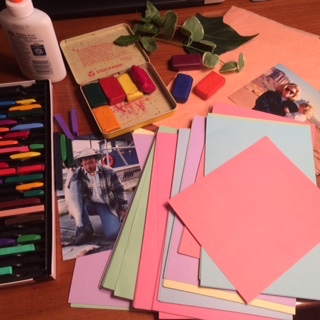 Our guest blogger is AGE-u-cate Master Trainer, Sue Wilson, LMSW, CADDCT, CDP – 360 Elder Solutions (www.360eldersolutions.com)
Our guest blogger is AGE-u-cate Master Trainer, Sue Wilson, LMSW, CADDCT, CDP – 360 Elder Solutions (www.360eldersolutions.com)
In this article you’ll learn how to use collage making as a creative means to engage with your loved one living with dementia and enable their voice. You do not have to be an artist to enjoy the benefits of collage making. Making a collage involves choosing images, shapes, and ‘bits and pieces’, then arranging them, and gluing them onto a surface. Collages can be wildly complicated, beautifully simple, or anywhere in between. It’s the opportunities to make choices, express preferences and feelings, and create that empowers an individual and give them voice. Over time, brain changes caused by Alzheimer’s and other dementias diminish language abilities making it progressively harder to engage with others. It becomes more difficult to understand the spoken words of others and to verbally express personal preferences, needs, thoughts and feelings. Losing the ability to effectively communicate can cause frustration and isolation and lead to anger, loneliness and boredom. Art provides a positive and meaningful way to communicate when words are not readily available. Supplies Gather an assortment of meaningful items that communicate your loved one’s current and past interests and preferences. Collages can be made from just about anything and do not require a trip to the craft store. Step outside, into your garage, or look in your “everything” drawer! Gather items that are appealing and will help tell a story. Such as:
• Photos of family members, a favorite car, images and items related to past military service, employment and hobbies, school days, honors earned, celebrations, a favorite pet are elements of life stories for reminiscing and person-‐centered care.
• For gardeners and nature buffs, gather fresh or dried leaves, dirt, seeds and blossoms to add life and texture to collages. Collect colorful and interesting treasures on a nature walk.
• Gather old magazines, color tissue paper, ribbons, fabric scraps and even old ties, large buttons, construction paper, crayons, and markers from around the house. Or, if needed pick some up at the grocery store.
• Sprinkle a few drops of vanilla, lavender, peppermint, or citrus essential oils on the fabric squares to engage the sense of smell. Apply favorite spices, perfumes or colognes.
- Have glue sticks for paper, or glues for fabric or wood items.
• Stray puzzle pieces, scrabble letters, dominoes, playing cards and other game pieces.
• Poster board and construction paper work well as surfaces for paper collages, but use a sturdier surface when incorporating embellishments.
• Grow and vary collage supplies to meet and engage changing abilities, interest and preferences.
Set up
• Minimize distractions.
• Decide what you are going to glue the collage onto.
• Set out a variety of papers, images, bits and pieces and see what sparks interest. What is of interest today may not be interesting tomorrow.
• Items can be grouped into themes and placed in separate baskets and brought out on different occasions.
• Help get things started with positive comments and simple instructions. It can be difficult for individuals in later stages of dementia to get started so start by sifting through images and pieces, ask for help in selecting items and with arranging them onto the surface.
• Wait for a response and create the opportunity for reminiscence.
• As time goes on, an individual living with dementia is more apt to recognize faces and places from young adulthood, teenage years, and early childhood, which trigger early emotional thoughts and feelings.
• Images can be torn or cut from magazines and catalogues, same with strips or shapes of paper. Photocopies work as well as original photos.
• The possibilities are endless.
Do:
• Relax. It is as important for you to lay down sweet memories of your loved one now as it is for them to have your presence and company in the now.
• Pay attention to what sparks interest.
• Reminisce enjoyable moments and give compliments when looking at photos and images. For example: o How handsome or beautiful they look in a particular photo. o How proud you are of them for the award they received. o How well they played golf or when they got a hole in one. o Describe the smell and taste of the amazing chocolate cake they made – say something like “I think that was your mother’s recipe.” How fun and exciting it was when you were out on the lake and they caught that giant trout. o Your compliments will help them enjoy their feelings associated with images, textures or scents.
• Pay attention to when your loved one starts tiring.
• Keep supplies handy and growing so art becomes a regular part of your rhythm and routine.
• Make note of items most enjoyed, changing abilities and moods.
• Display collages and share as gifts. These will become lasting treasures.
Don’t
- Overwhelm with too many choices.
- Hurry the process or take over. It is all about the process and not the product. • Ask your loved one if they remember the name of a particular person or place.
- Put your loved one on the spot by reminding them of what they do not remember.
- For more ideas of using creative expression and art to engage your loved one in meaningful activities, contact Sue S. Wilson, LMSW, CADDCT, CDP at sue@360eldersolutions.com and visit her website at www.360eldersolutions.com.